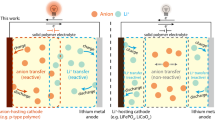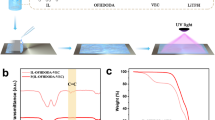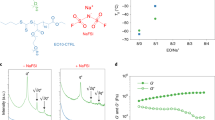Abstract
Nonaqueous lithium-oxygen (Li-O2) batteries have attracted increasing attention as potential candidates for next-generation batteries due to their significantly high theoretical energy densities. However, they are still in their infancy due to numerous problems. In this study, a cross-linked single-ion conducting polymer network with a highly delocalized anionic group was coated onto a thin commercial polyethylene membrane separator via a facile UV polymerization method. The resulting polymer coating improves the electrolyte wettability and suppresses the diffusion of anionic species across the separator. The effect of the polymer modification of the separator on the electrochemical properties of nonaqueous Li-O2 cells was investigated.
This is a preview of subscription content, access via your institution
Access options
Subscribe to this journal
Receive 12 print issues and online access
$259.00 per year
only $21.58 per issue
Buy this article
- Purchase on Springer Link
- Instant access to full article PDF
Prices may be subject to local taxes which are calculated during checkout









Similar content being viewed by others
References
Padbury R, Zhang X. Lithium–oxygen batteries—Limiting factors that affect performance. J Power Sources. 1999;196:4436–44.
Lu YC, Gallant BM, Kwabi DG, Harding JR, Mitchell RR, Whittingham MS, et al. Lithium-oxygen batteries: Bridging mechanistic understanding and battery performance. Energy Environ Sci. 2013;6:750–68.
Grande L, Paillard E, Hassoun J, Park J-B, Lee Y-J, Sun Y-K, et al. The Lithium/Air Battery: Still an emerging system or a practical reality? Adv Mater. 2015;27:784–800.
Yi J, Guo S, He P, Zhou H. Status and prospects of polymer electrolytes for solid-state Li–O2 (air) batteries. Energy Environ Sci. 2017;10:860–84.
Tong B, Huang J, Zhou Z, Peng Z. The salt matters: enhanced reversibility of Li-O2 batteries with a Li[(CF 3 SO 2)(n -C 4 F 9 SO 2)N]-based electrolyte. Adv Mater. 2018;30:1704841.
Liu Z, Huang J, Zhang Y, Tong B, Guo F, Wang J, et al. Taming interfacial instability in lithium–oxygen batteries: A polymeric ionic liquid electrolyte solution. Adv Energy Mater. 2019;9:1901967.
Kim JH, Kannan AG, Woo HS, Jin DG, Kim W, Ryu K, et al. A bi-functional metal-free catalyst composed of dual-doped graphene and mesoporous carbon for rechargeable lithium-oxygen batteries. J Mater Chem A. 2015;3:18456–65.
Kim JH, Woo HS, Kim WK, Ryu KH, Kim DW. Improved cycling performance of lithium-oxygen cells by use of a lithium electrode protected with conductive polymer and aluminum fluoride. ACS Appl Mater Interfaces. 2016;8:32300–6.
Woo HS, Moon YB, Seo S, Lee HT, Kim DW. Semi-interpenetrating polymer network composite gel electrolytes employing vinyl-functionalized silica for lithium-oxygen batteries with enhanced cycling stability. ACS Appl Mater Interfaces. 2018;10:687–95.
Ue M, Sakaushi K, Uosaki K. Basic knowledge in battery research bridging the gap between academia and industry. Mater Horiz. 2020;7:1937–54.
Chen Y, Freunberger SA, Peng Z, Fontaine O, Bruce PG. Charging a Li-O2 battery using a redox mediator. Nat Chem. 2013;5:489–94.
Liang Z, Lu YC. Critical role of redox mediator in suppressing charging instabilities of lithium-oxygen batteries. J Am Chem Soc. 2016;138:7574–83.
Lee DJ, Lee H, Kim Y-J, Park J-K, Kim H-T. Sustainable Redox mediation for lithium-oxygen batteries by a composite protective layer on the lithium-metal anode. Adv Mater. 2016;28:857–63.
Ryu WH, Gittleson FS, Thomsen JM, Li J, Schwab MJ, Brudvig GW, et al. Heme biomolecule as redox mediator and oxygen shuttle for efficient charging of lithium-oxygen batteries. Nat Commun. 2016;7:1–10.
Xin X, Ito K, Kubo Y. Highly efficient Br–/NO3– dual-anion electrolyte for suppressing charging instabilities of Li–O2 batteries. ACS Appl Mater Interfaces. 2017;9:25976–84.
Park J-B, Lee SH, Jung H-G, Aurbach D, Sun Y-K. Redox mediators for Li-O2 batteries: Status and perspectives. Adv Mater. 2018;30:1704162.
Lacey MJ, Frith JT, Owen JR. A redox shuttle to facilitate oxygen reduction in the lithium air battery. Electrochem Commun. 2013;26:74–6.
Yang L, Frith JT, Garcia-Araez N, Owen JR. A new method to prevent degradation of lithium-oxygen batteries: Reduction of superoxide by viologen. Chem Commun. 2015;51:1705–8.
Gao X, Chen Y, Johnson L, Bruce PG. Promoting solution phase discharge in Li-O2 batteries containing weakly solvating electrolyte solutions. Nat Mater. 2016;15:882–8.
Kim BG, Kim J-S, Min J, Lee Y-H, Choi JH, Jang MC, et al. A moisture- and oxygen-impermeable separator for aprotic Li-O2 batteries. Adv Funct Mater. 2016;26:1747–56.
Aetukuri NB, Kitajima S, Jung E, Thompson LE, Virwani K, Reich M-L, et al. Flexible ion-conducting composite membranes for lithium batteries. Adv Energy Mater. 2015;5:1500265.
Choi W, Kim M, Park JO, Kim J-H, Choi K, Kim YS, et al. Ion-channel aligned gas-blocking membrane for lithium-air batteries. Sci Rep. 2017;7:12037.
Qiao Y, Wang Q, Mu X, Deng H, He P, Yu J, et al. Advanced hybrid electrolyte Li-O2 Battery realized by dual superlyophobic membrane. Joule. 2019. https://doi.org/10.1016/j.joule.2019.09.002.
Meini S, Solchenbach S, Piana M, Gasteiger HA. The Role of electrolyte solvent stability and electrolyte impurities in the electrooxidation of Li2 O2 in Li-O2 batteries. J Electrochem Soc. 2014;161:A1306–A1314.
Zhang M, Takahashi K, Uechi I, Takeda Y, Yamamoto O, Im D, et al. Water-stable lithium anode with Li 1.4 Al 0.4 Ge 1.6 (PO 4) 3 -TiO 2 sheet prepared by tape casting method for lithium-air batteries. J Power Sources. 2013;235:117–21.
Bergner BJ, Busche MR, Pinedo R, Berkes BB, Schröder D, Janek J. How to improve capacity and cycling stability for next generation Li-O2 batteries: Approach with a Solid electrolyte and elevated redox mediator concentrations. ACS Appl Mater Interfaces. 2016;8:7756–65.
Kwak W-J, Jung H-G, Aurbach D, Sun Y-K. Optimized bicompartment two solution cells for effective and stable operation of Li-O2 batteries. Adv Energy Mater. 2017;7:1701232.
Wu S, Qiao Y, Deng H, Zhou H. A single ion conducting separator and dual mediator-based electrolyte for high-performance lithium–oxygen batteries with non-carbon cathodes. J Mater Chem A. 2018;6:9816–22.
Meziane R, Bonnet J-P, Courty M, Djellab K, Armand M. Single-ion polymer electrolytes based on a delocalized polyanion for lithium batteries. Electrochim Acta. 2011;57:14–9.
Feng S, Shi D, Liu F, Zheng L, Nie J, Feng W, et al. Single lithium-ion conducting polymer electrolytes based on poly[(4-styrenesulfonyl)(trifluoromethanesulfonyl)imide] anions. Electrochim Acta. 2013;93:254–63.
Bouchet R, Maria S, Meziane R, Aboulaich A, Lienafa L, Bonnet J-P, et al. Single-ion BAB triblock copolymers as highly efficient electrolytes for lithium-metal batteries. Nat Mater. 2013;12:452–7.
Zhang H, Li C, Piszcz M, Coya E, Rojo T, Rodriguez-Martinez LM, et al. Single lithium-ion conducting solid polymer electrolytes: advances and perspectives. Chem Soc Rev. 2017;46:797–815.
Lee SH, Park J-B, Lim H-S, Sun Y-K. An advanced separator for Li-O2 batteries: Maximizing the effect of redox mediators. Adv Energy Mater 2017;7:1602417.
Deng H, Qiao Y, Wu S, Qiu F, Zhang N, He P, et al. Nonaqueous, metal-free, and hybrid electrolyte Li-Ion O2 battery with a single-ion-conducting separator. ACS Appl Mater Interfaces. 2019;11:4908–14.
Imani M, Sharifi S, Mirzadeh H, Ziaee F. Monitoring of Polyethylene glycol-diacrylate-based hydrogel formation by real time NMR spectroscopy. Iran Polym J. 2007;16:13–20.
Wu A, Lu F, Sun P, Qiao X, Gao X, Zheng L. Low-molecular-weight supramolecular ionogel based on host–guest interaction. Langmuir. 2017;33:13982–9.
Kichambare P, Kumar J, Rodrigues S, Kumar B. Electrochemical performance of highly mesoporous nitrogen doped carbon cathode in lithium-oxygen batteries. J Power Sources. 2011;196:3310–6.
Yang XH, Xia YY. The effect of oxygen pressures on the electrochemical profile of lithium/oxygen battery. J Solid State Electrochem. 2010;14:109–14.
Lin X, Zhou L, Huang T, Yu A. Hierarchically porous honeycomb-like carbon as a lithium–oxygen electrode. J Mater Chem A. 2013;1:1239–45.
Chamaani A, Safa M, Chawla N, El-Zahab B. Composite Gel polymer electrolyte for improved cyclability in lithium-oxygen batteries. ACS Appl Mater Interfaces. 2017;9:33819–26.
Acknowledgements
This work was supported in part by the Iketani Science and Technology Foundation and Grants-in-Aid for Scientific Research (No. 20K15349 to RT) from the Ministry of Education, Culture, Sports, Science, and Technology of Japan. This work also received support from the National Institute for Materials Science (NIMS) Battery Research Platform. PP and KS are indebted to the NIMS Internship Program.
Author information
Authors and Affiliations
Corresponding author
Ethics declarations
Conflict of interest
The authors declare that they have no conflict of interest.
Additional information
Publisher’s note Springer Nature remains neutral with regard to jurisdictional claims in published maps and institutional affiliations.
Rights and permissions
About this article
Cite this article
Poungsripong, P., Tamate, R., Ono, M. et al. Fabrication of single-ion conducting polymer-coated separators and their application in nonaqueous Li-O2 batteries. Polym J 53, 549–556 (2021). https://doi.org/10.1038/s41428-020-00449-9
Received:
Revised:
Accepted:
Published:
Issue Date:
DOI: https://doi.org/10.1038/s41428-020-00449-9



